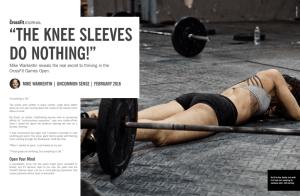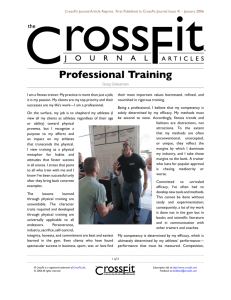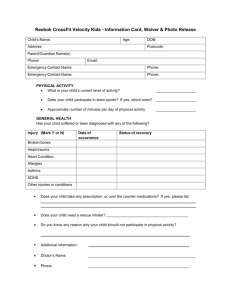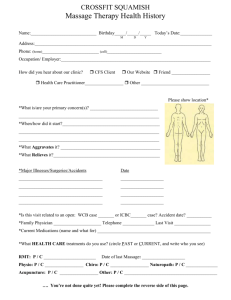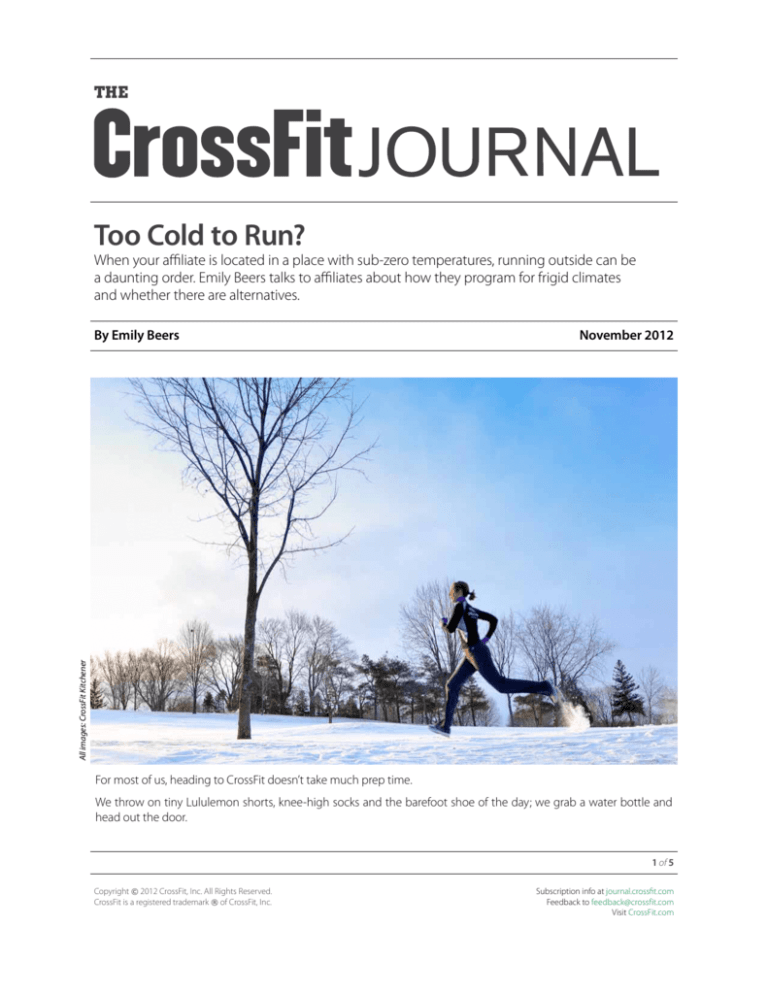
Too Cold to Run?
When your affiliate is located in a place with sub-zero temperatures, running outside can be
a daunting order. Emily Beers talks to affiliates about how they program for frigid climates
and whether there are alternatives.
November 2012
All images: CrossFit Kitchener
By Emily Beers
For most of us, heading to CrossFit doesn’t take much prep time.
We throw on tiny Lululemon shorts, knee-high socks and the barefoot shoe of the day; we grab a water bottle and
head out the door.
1 of 5
Copyright © 2012 CrossFit, Inc. All Rights Reserved.
CrossFit is a registered trademark ® of CrossFit, Inc.
Subscription info at journal.crossfit.com
Feedback to feedback@crossfit.com
Visit CrossFit.com
Cold ...
(continued)
But for CrossFitters in winter cities that see hypothermic
temperatures for months at a time, it’s a little more
challenging than this.
Their mornings include an additional five layers of
clothing and a search for the warmest jacket and mittens
they can find before heading out the door into Arctic-like
conditions for their first WOD: scraping the car and
shoveling the driveway.
“We tell people to layer in
three layers in the winter—a
tank top, a long-sleeved shirt
and then a sweatshirt so they
can effectively warm up.”
—Melissa Gerharter
Melissa Gerharter of CrossFit Joust in Ann Arbor, Mich., is
all too familiar with the challenges that arise when belowfreezing temperatures arrive each November.
“Just keeping our industrial space warm is hard,” she said.
“We keep our box at 50 degrees, which leads to cold
Olympic-lifting bars and kettlebells. We tell people to layer
in three layers in the winter—a tank top, a long-sleeved
shirt and then a sweatshirt so they can effectively warm up.”
Like Gerharter in Michigan, “Fun” Bobby Kwasny of CrossFit
SubZero in Thunder Bay, Ont., trains in conditions that
freeze his nose hairs the second he steps out the door.
Kwasny, who grew up in the northern Ontario city, admits
that he avoids being outside in the winter months as
much as possible.
“I’m actually—and I’m serious here—allergic to the cold,
and it seems to be getting worse as I age,” he said.
What Kwasny is referring to is a very real condition called
cold urticaria, an allergy from exposure to a cold stimulus
that causes hives or large red welts on the skin.
And the challenge doesn’t end there for Kwasny or the
other freeze-your-ass-off affiliates. Once they deal with
their welts and warm up their boxes and bodies enough
to train, they’re presented with a CrossFit-specific
dilemma: running.
Next challenge: building a snowman for time.
2 of 5
Copyright © 2012 CrossFit, Inc. All Rights Reserved.
CrossFit is a registered trademark ® of CrossFit, Inc.
Subscription info at journal.crossfit.com
Feedback to feedback@crossfit.com
Visit CrossFit.com
Cold ...
(continued)
No matter how you slice it, running is one of the most
functional movements in the world. It’s crucial to
CrossFit, not just as a movement, but also for improving
cardiovascular endurance and stamina.
Lauren McClintock, who lives in the Yukon Territory in
Canada, can attest to the “northern folk” strength. Last year,
McClintock moved to the Yukon from a much milder part
of British Columbia and still is adapting to the cold climate.
But what if your running terrain is covered with ice and
snow for five months of the year and the air is so cold your
lungs hurt when you take a deep breath?
“You either come here and you love it or you hate it,” said
McClintock, who admitted it has been a challenge trying
to CrossFit outside in the winter. “But the locals are out
there running, even in the coldest of days. There’s even a
crazy ultra-marathon race here every year in February.”
Suck It Up
When I started CrossFit in London, Ont., three years ago, I
was unaware that running was a CrossFit movement. With
icy roads and a foot of snow in the trails, running didn’t
seem like a pleasant pastime for much of the year.
People in the Yukon are “just extreme,” McClintock added.
“Even CrossFitters keep running in the winter. They just
throw YakTrax on their shoes, and cyclists throw winter
tires on their bikes. I even have a co-worker who bikes to
work every day, all winter,” she said.
“I remember being close
to tears on some of my long
runs because my hips and
calves ached so bad.”
—Joanne Mittelholtz
When the snow melted in April, my coach programmed
Helen. Much to my disappointment, I found myself
running for the first time in five months.
Joanne Mittelholtz is the owner of CrossFit Kitchener,
about an hour away from London, Ont. From November
until the end of March, Kitchener has snow on the ground
and sees below-freezing temperatures. But this doesn’t
stop her from running or from getting her clients to hit the
wintery streets on foot.
“Us northern folks are tough,” Mittelholtz said. “We run all
year … but it’s definitely the conditions—not the cold—
that would keep us from running.”
Mittelholtz is a true runner. She trained for the Boston
marathon in 2008 and 2009 in –30 C and in some horribly
icy conditions.
“I remember being close to tears on some of my long runs
because my hips and calves ached so bad,” she said. “So
whenever members whine about running 400s and 800s
in a winter WOD, I tell them to suck it up.”
Polar bear Joanne Mittelholtz is one affiliate owner who
doesn’t let the weather determine her programming.
3 of 5
Copyright © 2012 CrossFit, Inc. All Rights Reserved.
CrossFit is a registered trademark ® of CrossFit, Inc.
Subscription info at journal.crossfit.com
Feedback to feedback@crossfit.com
Visit CrossFit.com
Cold ...
(continued)
Snow tires?
“You have to find a way to keep exercising outside up here
during the winter or else you get depressed.”
“There is no chance anyone
is doing running WODs
outside at CrossFit SubZero
in the winter.”
—Bobby Kwasny
McClintock said she isn’t ready to run in mid-December,
but she picked up cross-country skiing this winter to give
her some much-needed fresh air.
Although she has enjoyed her foray into skiing so far, she
does crave the milder weather sometimes.
“I do miss having those garage doors open all year round,
and to be able to drop a weight and fly out the door and
run,” she said.
Running Substitutes
Unlike the run-all-year-round folks in Kitchener and
the Yukon, many CrossFit affiliates in cold-winter cities
have found other ways to maintain their cardiovascular
endurance and stamina without freezing on the icy streets.
Kwasny, whose mascot at CrossFit SubZero is a jacked-up
snowman named Marion, doesn’t bother trying to fight the
frigid temperatures that come his way each year.
4 of 5
Copyright © 2012 CrossFit, Inc. All Rights Reserved.
CrossFit is a registered trademark ® of CrossFit, Inc.
Subscription info at journal.crossfit.com
Feedback to feedback@crossfit.com
Visit CrossFit.com
Cold ...
(continued)
“There is no chance anyone is doing running WODs
outside at CrossFit SubZero in the winter,” he said. “There
are people—mostly the crazy-ass Finns that live here—
that run year round, but they don’t have to come inside,
knock off 20 chins and 10 heavy deadlifts, then re-bundle
themselves and go smoke another 400 meters.”
“We use the winter months
to build as much horsepower
as possible.”
—Bobby Kwasny
Both Kwasny and Gerharter program a lot of rowing and
burpees during the winter months to maintain aerobic
fitness. And, of course, they do a lot of double-unders.
It’s obviously not the same as running, but Kwasny and
Gerharter agree it’s better than nothing.
Alex Cibiri, of Element CrossFit in Mississauga, Ont., said
he doesn’t think burpees and rowing are adequate substitutes for running. He has two treadmills in his box. One
of them is a more challenging self-powered treadmill that
“really sucks … in a good way,” he said.
“Lots of people wonder why we bother with treadmills, but
to me cutting out all running during the winter months
isn’t an option for my running clients,” he said. “I want to be
able to facilitate training various types of clients, even if I
hate running myself.”
But with only two treadmills for 200 clients, it’s impossible
to keep them all running all the time, so like the other
affiliates, he resorts to double-unders, burpees and burpee
box jumps to provide aerobic conditioning.
A Time to Strength Train
For Kwasny’s Thunder Bay crew, when the cold comes,
it’s simply a time to work on other important elements
of CrossFit.
In a way, the winter has created a sort of forced
periodization for Kwasny’s programming, which he said
has benefited his athletes.
“I learned a long time ago that any obstacle can be an
opportunity, so yeah it sucks that we can’t be outside for
five months of the year, but we use the winter months to
build as much horsepower as possible,” he said.
Those who make it through the winter become “strong as
fuck,” Kwasny said.
“So in the spring, when we start running 400-meter repeats
and tossing kegs around, you see guys that couldn’t lift the
135-lb. keg last year tossing it up like it’s the 90-lb. keg this
year, and athletes that couldn’t break 1:30 in the 400 meter
last year running six sub-1:20 repeats first time out.”
And the truth is, despite his allergy to the cold, Kwasny
said he loves living in Thunder Bay. He has adjusted to the
–40 C way of life the same way the average CrossFitter has
adapted to busting out 100 squats a few times a week.
“Weather is like life: if you are prepared, you can deal with
anything,” he said. “So if you plug in your car, pay the kid up
the street to shovel your driveway, bundle up and don’t be
a fucking pansy, winter can be pretty manageable.”
F
About the Author
Emily Beers is a CrossFit Journal staff writer and editor who
finished a master’s degree in journalism at the University of
Western Ontario in the spring of 2009. Upon graduation, she
worked as a sportswriter at the 2010 Vancouver Winter Olympic
Games, where she covered figure skating and short-track speed
skating. Currently, she hosts WOD HOG, a not-always-PG
publication of the CrossFit Vancouver School of Fitness. She
ruptured her Achilles tendon in December 2010 and served as
the Canada West Regional Media Director while recovering
from surgery. Beers also competed in the 2011 Reebok CrossFit
Games on CrossFit Vancouver’s team. She finished third at the
Canada West Regional in 2012.
“In our gym, our motto is, ‘There is no substitute for
strength,’” he said. “It doesn’t matter how cold and shitty it
is outside. It is 60 degrees and sunny in the gym and the
335 lb. on the bar is still 335 lb., and it doesn’t give two
shits that you had to shovel your driveway and your car
didn’t start.”
5 of 5
Copyright © 2012 CrossFit, Inc. All Rights Reserved.
CrossFit is a registered trademark ® of CrossFit, Inc.
Subscription info at journal.crossfit.com
Feedback to feedback@crossfit.com
Visit CrossFit.com

